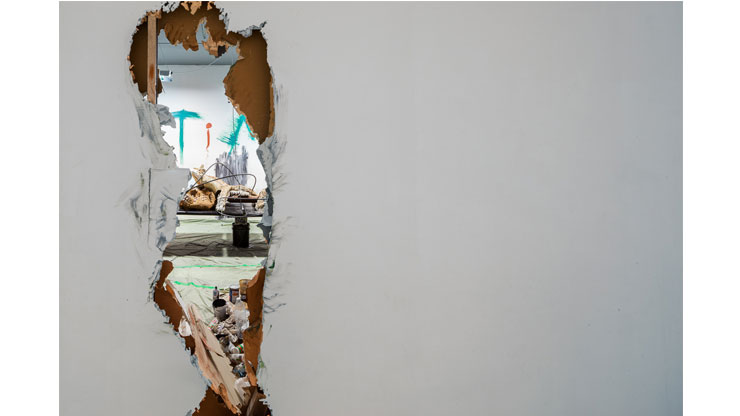Avi Nevo | Tremolo
The works of Avi Nevo (b. 1980) seem like the fruit of true despair, which grow neither from coming to terms nor from rebellion but rather from the involuntary, instinctive movement of a hopeless body. Accumulations of despairing moves, with one’s back to the wall. Not an attempt to break free of one’s shackles, but rather shaking the body like the spasm of a cultural and aesthetic organism which realizes it has reached a dead end,yet the blood still insists on flowing through it and the body is compelled to go on moving. The cultural contexts are at times familiar and at other times less so, but even if Jonathan Meese or Cathy Wilkes are somehow present in these works, Nevo’s version seems more disturbed and not as comforting.
The texts inscribed on some of the works (in English, Nevo’s mother tongue) make them even more homeless, and without a home despair is not as comfortable. These works do not exhibit the usual self-satisfaction of Israeli art, which has felt comfortable among street materials and the local aesthetic of meagerness. Here there are broken quotations, as if uttered by a person with Tourette syndrome, of remnants of Punk and trash culture which did not originate in this place and, in fact,have long existed mainly as a stage set, without substantial
faith, certainly none related to social outlook or protest. Nevo may be exposing here a despair that surpasses the personal or idiosyncratic. The cultural and religious despair of a generation without hope yet full of libido.
“Tremolo,” the title of the exhibition, is a musical term denoting rapid reiteration of a single note. The sense of unease provoked by the tremolo, particularly when protracted for a long time, is a charged, disturbing effect which finds plastic and conceptual expression in Nevo’s work. A large skateboardlike improvised structure resembles a monument erected by friends by the side of the road or a dismantled amateur sculpture awaiting cleanup. On top of the surface there are papier-mâché lumps covered with seashells stuck onto a net, recalling fragments of the kurkar sandstone at Sidna Ali beach (in Arabic, “Our master Ali”) in Herzliya, where for the past forty years Nissim Kahlon has been building, between the sea and real-estate ventures, a disintegrating mini-utopia called Miracle Cave. The collection of crumbling structures attached to the kurkar hillside have turned into one individual’s stubborn struggle to create his own world in a bureaucratic air-pocket between the Israel Land Authority and the Herzliya municipality.
This, too, like Nevo’s work, is an impressive struggle with one’s back to the wall and one’s face to the sea.
